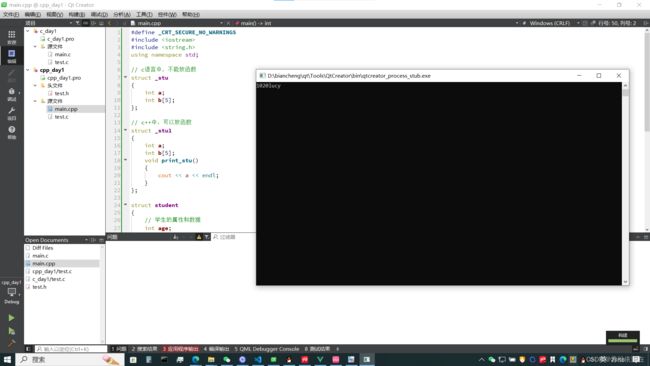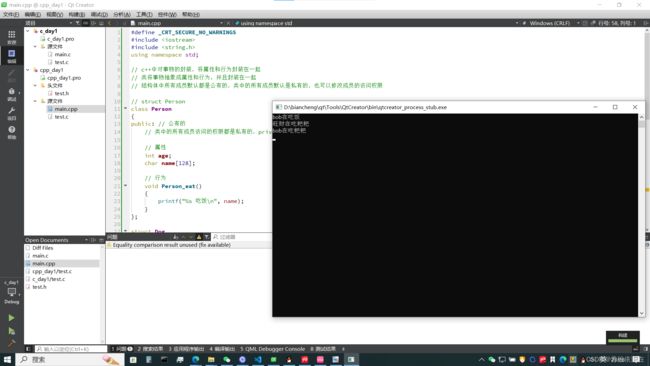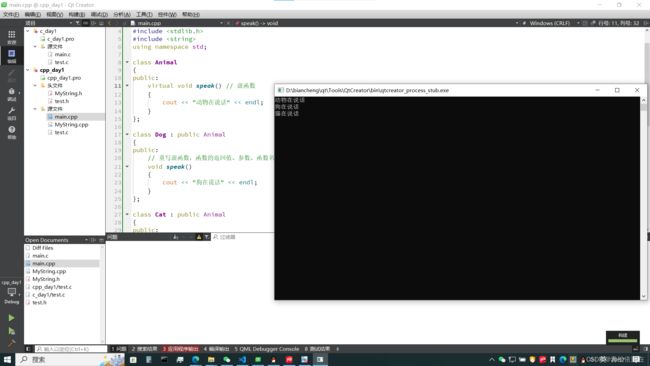嵌入式开发学习(C++2-类和对象)
1 类和对象的基本概念
1.1 c和c++中struct的区别
- c语言中结构体中不能存放函数,也就是数据(属性)和行为(方法)是分离的
- c++中结构体中是可以存放函数的,也就是数据(属性)和行为(方法)是封装在一起的
#define _CRT_SECURE_NO_WARNINGS
#include 1.2 C语言中表示事物的方法存在的问题
c语言中表示事物时,将属性和行为分离,有可能行为调用出错
#include 1.3 c++中对事物的封装/类
- c++将事物的属性和行为封装在一起,叫类
- 类和结构体的一个区别在于,类对成员可以进行访问的权限控制,结构体不可以
- 类 = 类型(事物的行为和属性),类实例化出来的变量叫对象
- 类中的函数可以访问类里面的成员
#define _CRT_SECURE_NO_WARNINGS
#include 1.4 类中的成员权限
- 公有,类内类外都可访问
- 保护,类外不可访问,类内是可以访问,子类可以访问
- 私有,类外不可访问,类内是可以访问,子类不可访问
#define _CRT_SECURE_NO_WARNINGS
#include 1.5 尽量设置成员变量为私有权限
设置成员变量为私有,优点:
- 对变量的设置时的控制
- 可以给变量设置只读权限
- 可以给变量设置只写权限
- 可以给变量设置可读可写权限
例如
class AccessLevels
{
public:
// 对只读属性进行只读访问
int getReadOnly() { return readOnly; }
// 对只写属性进行只写访问
void setWriteOnly(int val) { writeOnly = val; }
// 对读写属性进行读写访问
void setReadWrite(int val) { readWrite = val; }
int getReadWrite() { return readWrite; }
private:
int readOnly; // 对外只读访问
int noAccess; // 外部不可访问
int readWrite; // 读写访问
int writeOnly; // 只写访问
};
1.6 示例(一个类)
#define _CRT_SECURE_NO_WARNINGS
#include 2 面向对象设计案例
2.1 立方体案例
#define _CRT_SECURE_NO_WARNINGS
#include 2.2 点和圆的关系
#define _CRT_SECURE_NO_WARNINGS
#include 3 构造和析构
3.1 构造和析构的概念
- 创建对象时,对对象进行初始化的工作,就是构造;
- 销毁对象时,对对象进行清理工作,就是析构;
- 构造和析构函数一般需要人为提供,如果不提供,那么编译器也会给提供,只是编译器提供的构造和析构函数不会做任何操作;
- 创建对象时和释放对象时,构造函数和析构函数自动会调用,不需要人为调用;
3.2 构造函数和析构函数
构造函数:
- 没有返回值
- 函数名和类名一致
- 有参数,参数可以有多个
- 可以发送函数的重载
- 创建对象时,会自定调用
析构函数:
- 没有返回值
- 函数名:类名前面加上~
- 没有参数
- 不能发送函数的重载
- 销毁对象之前,回被自动调用
#define _CRT_SECURE_NO_WARNINGS
#include 3.3 构造函数的分类
无参构造和有参构造,普通构造和拷贝构造
拷贝构造函数的写法:
类名(const 类名 &obj) {}
注意:
- 如果自定义了一个构造函数,系统将不再提供默认的构造函数
- 如果自定义了一个拷贝构造,系统将不再提供默认的拷贝构造
- 默认的拷贝构造是简单的值拷贝
- 如果创建对象时,不能调用对应的构造函数,将不能创建出对象
#define _CRT_SECURE_NO_WARNINGS
#include // explicit 关键字 // 修饰构造函数,作用是不能通过隐式法调用构造函数
explicit Person(const Person &p) {}
void test1()
{
cout << "匿名" << endl;
// 匿名对象,没有名字,生命周期在当前行
Person(10, "lucy"); // 调用了有参构造创建了一个匿名对象
Person(); // 调用了无参构造创建了一个匿名对象
Person p1(20, "heihei");
// Person (p1);//在定义时匿名对象不能使用括号法调用拷贝构造
cout << endl;
}
// 显示法调用构造函数
void test2()
{
cout << "显示法" << endl;
Person p1 = Person(10, "lucy"); // 显示法调用有参构造
Person p2 = Person(p1); // 显示法调用拷贝构造
Person p3 = Person(); // 显示法调用无参构造
cout << endl;
}
// 隐式法调用构造函数
void test3()
{
cout << "隐式法" << endl;
Person p1 = {10, "lucy"}; // 隐式法调用有参构造
// Person p2 = p1; // 隐式法调用拷贝构造
// Person p3 ;// 隐式法不能调用无参构造
}
3.4 拷贝构造函数的调用时机
总结一种情况:旧对象初始化新对象时
三种情况:
- 旧对象初始化新对象时
- 形参是一个对象时
- 返回局部对象时
#define _CRT_SECURE_NO_WARNINGS
#include 3.5 c++默认增加的函数
默认情况下,c++编译器至少为我们写的类增加3个函数
- 默认构造函数(无参,函数体为空)
- 默认析构函数(无参,函数体为空)
-默认拷贝构造函数,对类中非静态成员属性简单值拷贝
如果用户定义拷贝构造函数,c++不会再提供任何默认构造函数;
如果用户定义了普通构造(非拷贝),c++不在提供默认无参构造,但是会提供默认拷贝构造;
3.6 构造函数的浅拷贝和深拷贝
3.6.1 浅拷贝
拷贝值,不拷贝地址(系统默认拷贝就是浅拷贝)
#define _CRT_SECURE_NO_WARNINGS
#include 3.6.2 深拷贝
拷贝值和地址
Person(const Person &p)
{
mAge = p.mAge;
name = (char *)malloc(strlen(p.name) + 1);
strcpy(name, p.name);
}
3.7 多个对象构造和析构
3.7.1 初始化列表
注意:
- 初始化列表,先声明再调用,构造函数时定义并初始化,定义初始化的顺序和声明的顺序一致
- 普通的构造函数,先定义再赋值
#define _CRT_SECURE_NO_WARNINGS
#include 3.7.2 类对象成为另一个类的成员
类中有多个对象时,构造的顺序是先构造里面的对象,再构造外面的对象;
类中有多个对象时,析构时顺序是先析构外面的对象,在析构里面的对象;
#define _CRT_SECURE_NO_WARNINGS
#include 3.8 explicit
c++提供了关键字explicit,禁止通过构造函数进行的隐式转换,声明为explicit的构造函数不能在隐式转换中使用;
explicit注意:explicit用于修饰构造函数,防止隐式转化,是针对单参数的构造函数(或者除了第一个参数外其余参数都有默认值的多参构造)而言;
3.9 动态对象创建
3.9.1 malloc和free动态申请对象和释放对象
使用malloc和free函数去动态申请对象,和释放申请的对象,不会调用构造函数和析构函数
#define _CRT_SECURE_NO_WARNINGS
#include 3.9.2 c++中动态申请对象和释放对象
普通对象:
类型 *p = new 类型;
delete p;
数组:
类型 *p = new 类型[n];
delete[] p;
#define _CRT_SECURE_NO_WARNINGS
#include 3.9.3 用于数组的new和delete
void test4()
{
// new时调用有参构造
person *p = new person(10);
delete p;
person *p1 = new person[10]; // 注意new对象的数组时不能调用有参构造 只能调用无参构造
delete[] p1;
}
3.9.4 delete void *问题
void test5()
{
void *p = new person;
delete p; // p的类型是void *,所以不会调用析构函数
}
3.9.5 使用new和delete采用相同形式
new单一对象时,使用delete释放单一的对象,new一个数组时,使用delete []释放这个数组
3.10 静态成员
在类定义中,它的成员(包括成员变量和成员函数),这些成员可以用关键字static声明为静态的,称为静态成员;
不管这个类创建了多少个对象,静态成员只有一个拷贝,这个拷贝被所有属于这个类的对象共享;
3.10.1 静态成员变量
- 静态成员变量在内存中只有一份,多个对象共享一个静态变量
- 静态成员变量,必须类内声明,类外定义
- 静态成员变量可以通过类的作用域访问
- 静态成员变量可以通过类的对象访问
#define _CRT_SECURE_NO_WARNINGS
#include 3.10.2 静态成员函数
- 静态成员函数能访问静态成员变量,不能访问普通的成员变量
- 可以通过类的作用域访问静态成员函数
- 可以通过对象访问静态成员函数
#define _CRT_SECURE_NO_WARNINGS
#include 3.10.3 const修饰的静态成员变量
- const修饰的静态成员变量保存在常量区,只读的,在内存中只有一份
- const修饰的静态成员变量可以在类内定义且初始化
- const修饰的静态成员变量可以通过类的作用域访问
- const修饰的静态成员变量可以通过对象访问
- 静态成员函数可以访问const修饰的静态成员变量
#define _CRT_SECURE_NO_WARNINGS
#include 3.10.4 单例模式
单例模式:一个类只能创建出一个对象
单例模式实现的步骤:
- 将无参构造私有化
- 将拷贝构造私有化
- 定义一个静态的成员指针变量,指向new出来的一个唯一对象
- 将静态的成员指针变量私有化,提供获得唯一对象的地址的静态接口
#define _CRT_SECURE_NO_WARNINGS
#include 4 类对象成员
4.1 成员变量和函数的存储
- 普通成员变量占用对象空间大小
- 静态成员变量不占用对象空间大小
- 普通成员函数不占用对象空间大小
- 静态成员函数不占用对象空间大小
#define _CRT_SECURE_NO_WARNINGS
#include 4.2 this指针的工作原理
类的成员函数默认编译器都加上了一个this指针,这个this指针指向调用该成员函数的对象
4.3 this指针的应用示例
#define _CRT_SECURE_NO_WARNINGS
#include 4.4 const修饰的成员函数
- 在函数后面加上const,这个是一个常函数
- 这个const修饰的是指针const type * const this,代表不能通过this指针去修改this指针指向对象的内容
// 常函数,不能通过this指针修改this指针指向的对象内容
// 常量指针常量
person person_addc(person &p2) const // const person * const this ------> p
{
// this->age = 200; // 不可修改
person p(this->age + p2.age, this->name + p2.name); //"helloworld"
return p;
}
5 友元
类的主要特点之一是数据隐藏,即类的私有成员无法在类的外部(作用域之外)访问;但是,有时候需要在类的外部访问类的私有成员,怎么办?
解决方法是使用友元函数,友元函数是一种特权函数,c++允许这个特权函数访问私有成员;
这一点从现实生活中也可以很好的理解:比如你的家,有客厅,有你的卧室,那么你的客厅是Public的,所有来的客人都可以进去,但是你的卧室是私有的,也就是说只有你能进去,但是呢,你也可以允许你的闺蜜好基友进去;
如果想要让全局函数或一个类的成员函数访问另一个类私有成员,只需要声明友元即可
5.1 全局函数成为类的友元
#define _CRT_SECURE_NO_WARNINGS
#include 5.2 类成为另一个类的友元,类的成员函数成为另一个类的友元
#define _CRT_SECURE_NO_WARNINGS
#include 6 运算符重载
6.1 运算符重载的基本概念
运算符重载:就是给运算符赋予一个新的意义;
运算符只能运算内置的数据类型,对于自定义的数据类型,不能运算,所以我们可以重载运算符;
语法:
返回值类型 operator运算符(类引用) {}
6.2 重载+运算符
#define _CRT_SECURE_NO_WARNINGS
#include 6.3 重载<<(配合友元函数)
#define _CRT_SECURE_NO_WARNINGS
#include 6.4 可以重载的运算符
C中几乎所有的运算符都可以重载,但重载运算符的使用相当受限制,特别是不能使用C中当前没有意义的运算符(例如用**求幂),不能改变运算符优先级,不能改变运算符的参数个数;
这样的限制有意义,否则,所有这些行为产生的运算符只会混淆原本的意义;
6.5 重载++/–运算符
++a; //先自加,再使用
a++; //先使用,在自加
// 前置加加返回的是引用,后置加加返回的是对象
// 前置加加调用TYPE& operator++()函数,后置加加调用的是TYPE operator++(int)函数,也就是后置加加多了一个占位参数
#define _CRT_SECURE_NO_WARNINGS
#include 6.6 智能指针
我们new一个对象,经常忘记释放,所以我们可以使用智能指针来维护;
智能指针实质是一个局部对象,这个局部对象维护了new出来的对象的地址,在局部对象的析构函数中,会帮忙释放new出来的对象;
对于智能指针我们重载了->和*,可以让智能指针和普通指针一样使用;
#define _CRT_SECURE_NO_WARNINGS
#include 6.7 重载=运算符
编译器默认给每一个类加上了4个函数
- 默认无参构造
- 默认的拷贝构造
- 析构
- operator=()
#define _CRT_SECURE_NO_WARNINGS
#include 6.8 重载==/!=
#define _CRT_SECURE_NO_WARNINGS
#include 6.9 函数对象
一个类中重载了()的类,那么整个类定义处的对象可以像函数一样使用,本质上是调用了operator()整个函数
#define _CRT_SECURE_NO_WARNINGS
#include 6.10 不要重载&&和||
不要重载&&和||的原因是,无法在这两种情况下实现内置操作符的完整语义;
说得更具体一些,内置版本特殊之处在于:内置版本的&&和||首先计算左边的表达式,如果这完全能够决定结果,就无需计算右边的表达式了——而且能够保证不需要,我们都已经习惯这种方便的特性了;
我们说操作符重载其实是另一种形式的函数调用而已,而且函数调用总是在函数执行之前对所有参数进行求值;
#define _CRT_SECURE_NO_WARNINGS
#include 6.11 重载运算符建议
- =,[],()和->操作符只能通过成员函数进行重载
- << 和 >>只能通过全局函数配合友元函数进行重载
- 不要重载&&和||操作符,因为无法实现短路规则
6.12 封装string类
6.12.1 MyString.h
#define _CRT_SECURE_NO_WARNINGS
#pragma once
#include 6.12.2 MyString.cpp
#include 6.12.3 main.cpp(测试)
#include 6.13 运算符优先级
7 继承
7.1 继承的概念
7.1.1 为什么需要继承
一个类继承另一个类,这样类中可以少定义一些成员,能很好的解决代码重复的问题
7.1.2 继承的概念
- c++最重要的特征是代码重用,通过继承机制可以利用已有的数据类型来定义新的数据类型,新的类不仅拥有旧类的成员,还拥有新定义的成员;
- 一个B类继承于A类,或称从类A派生类B;这样的话,类A成为基类(父类),类B成为派生类(子类);
- 派生类中的成员,包含两大部分:一类是从基类继承过来的,一类是自己增加的成员;从基类继承过过来的表现其共性,而新增的成员体现了其个性;
7.1.3 派生类的定方义法
派生类定义格式:
Class 派生类名 : 继承方式 基类名
{
// 派生类新增的数据成员和成员函数
}
三种继承方式:
- public,公有继承
- private,私有继承
- protected,保护继承
#define _CRT_SECURE_NO_WARNINGS
#include 7.2 派生类访问权限控制
#define _CRT_SECURE_NO_WARNINGS
#include 7.3 继承中的析构和构造
7.3.1 继承中的对象模型
在C++编译器的内部可以理解为结构体,子类是由父类成员叠加子类新成员而成
#define _CRT_SECURE_NO_WARNINGS
#include 7.3.2 对象构造和析构的调用原则
继承中的构造和析构
- 子类对象在创建时会首先调用父类的构造函数,父类构造函数执行完毕后,才会调用子类的构造函数
- 当父类构造函数有参数时,需要在子类初始化列表(参数列表)中显示调用父类构造函数
- 析构函数调用顺序和构造函数相反
#define _CRT_SECURE_NO_WARNINGS
#include 7.4 继承中同名成员的处理问题
如果子类和父类有同名的成员变量和成员函数,则继承时,父类的成员变量和成员函数会被隐藏
#define _CRT_SECURE_NO_WARNINGS
#include 7.5 非自动继承的函数
继承时,子类不会继承父类的构造函数,析构函数和operator=函数
7.6 继承中的静态成员特性
继承时,子类和父类有同名的静态成员函数或静态成员变量,父类中的静态成员函数或静态成员变量会被隐藏
#define _CRT_SECURE_NO_WARNINGS
#include 7.7 多继承
7.7.1 多继承的概念
即一个类继承了多个类
#define _CRT_SECURE_NO_WARNINGS
#include 7.7.2菱形继承和虚继承
为了解决多继承时的命名冲突和冗余数据问题,C++ 提出了虚继承,使得在派生类中只保留一份间接基类的成员
虚继承格式
class 子类 : virtual 继承方式 父类 {}
#define _CRT_SECURE_NO_WARNINGS
#include 8 多态
8.1 多态的概念
多态:一种接口,多种形态
静态多态:编译时,地址先绑定(静态联编)
动态多态:运行时,才确定需要调用的地址(动态联编)
发生多态的四个条件:
- 父类中有虚函数
- 必须发生继承
- 子类必须重写虚函数(函数的返回值,函数名,参数一致,函数内容可以不一致)
- 父类的指针或引用指向子类的对象
#define _CRT_SECURE_NO_WARNINGS
#include 8.2 多态实现计算器的案例
#define _CRT_SECURE_NO_WARNINGS
#include 8.3 c++如何实现动态绑定
C++中的动态绑定通过虚函数实现,而虚函数是通过一张虚函数表(virtualtable)实现的,拥有虚函数的类在实例化时会创建一张虚函数表;
这个表中记录了虚函数的入口地址,当派生类对虚函数进行重写时,虚函数表中相关虚函数的地址就会被替换,以保证动态绑定时能够根据对象的实际类型调用正确的函数;
8.4 纯虚函数和抽象类
纯虚函数:将虚函数等于0,实质是将虚函数表的函数入口地址设为NULL
抽象类:一个类中如果有纯虚函数,那么这个类就是一个抽象类,抽象类不能实例化对象
继承抽象类的子类也是一个抽象类,如果子类重写了虚函数,那么子类就不是抽象类
class Calc
{
public:
virtual int mycalc(int a, int b) = 0; // 虚函数等于0,纯虚函数
// {
// return 0;
// }
};
class Mod : public Calc
{
public:
// 子类继承了抽象类,那么子类也是一个抽象类
int mycalc(int a, int b) {} // 如果子类重写类虚函数,就不是抽象类
};
// 如果有纯虚函数的类,叫做抽象类,抽象类不能实例化对象
void test3()
{
// Calc p;
Mod p1;
}
8.5 纯虚函数和多继承
- 多继承带来了一些争议,但是接口继承可以说一种毫无争议的运用了;
- 绝大数面向对象语言都不支持多继承,但是绝大数面向对象对象语言都支持接口的概念,c++中没有接口的概念,但是可以通过纯虚函数实现接口;
- 接口类中只有函数原型定义,没有任何数据定义;
- 多重继承接口不会带来二义性和复杂性问题;
- 接口类只是一个功能声明,并不是功能实现,子类需要根据功能说明定义实现功能;
注意:除了析构函数外,其他声明都是纯虚函数
8.6 虚析构
作用:在调用基类的析构函数之前,会先调用子类的析构函
#define _CRT_SECURE_NO_WARNINGS
#include 8.7 纯虚析构
纯虚析构函数等于0
class Animal
{
public:
virtual void speak() // 虚函数
{
cout << "动物在说话" << endl;
}
virtual ~Animal() = 0; // 纯虚析构
// {
// cout << "Animal的析构" << endl;
// }
};
8.8 重载、重定义、重写
重载:
- 函数名相同
- 同一个作用域
- 参数的个数、顺序、类型不一致
- const也可以成为重载的条件
重定义:
- 发生继承
- 子类和父类有同名的变量和函数,父类中同名的变量和函数会被隐藏
重写:
- 父类中有虚函数
- 发生了继承
- 子类重写了虚函数,函数名、返回值、参数一致,函数体不一致







































